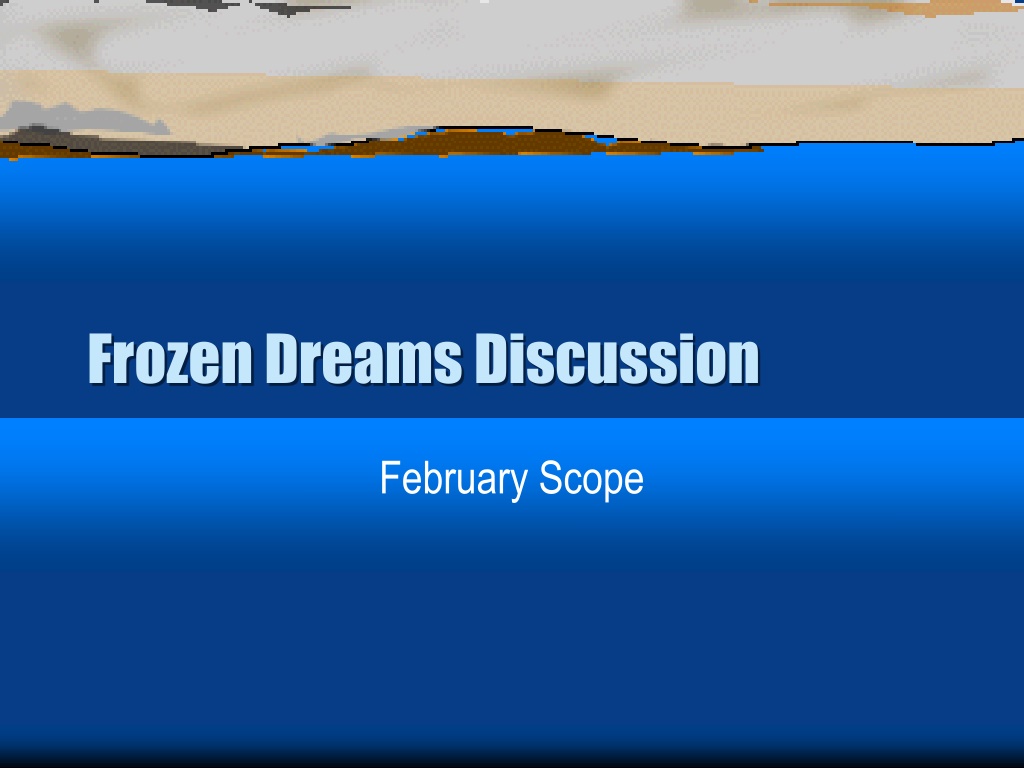Exploring Arctic Adventures: Frozen Dreams Discussion
Dive into the dangerous and courageous world of Arctic exploration with Lauren Tarshis' "Frozen Dreams DiscussionFebruary.Scope". Discover the challenges faced by Matthew Henson, the differences and similarities between Henson and Peary, and the significance of Henson's friendships with the Inuit in their Arctic expeditions.
Download Presentation

Please find below an Image/Link to download the presentation.
The content on the website is provided AS IS for your information and personal use only. It may not be sold, licensed, or shared on other websites without obtaining consent from the author. Download presentation by click this link. If you encounter any issues during the download, it is possible that the publisher has removed the file from their server.
E N D
Presentation Transcript
Frozen Dreams Discussion February Scope
In the first section, what details about the Arctic does author Lauren Tarshis include? Tarshis includes many details that convey how dangerous the Arctic is. For example, she writes that there are blinding blizzards and frigid water (5). She also explains that not even polar bears creatures that thrive in the cold go there, which shows just how inhospitable the region is.
Why is this information important to the story? (author s craft) These details are important to the story because they help the reader understand what Matthew Henson was facing as well as how courageous he was to have braved such a dangerous place.
Reread the section Fierce Ambitions. In what ways were Henson and Peary different? (compare and contrast) As a white man, Peary had many opportunities and was educated as an engineer. Henson did not have the same opportunities and battled constant discrimination. He was largely self-educated and had to take low-level jobs for which he was overqualified.
Reread the section Fierce Ambitions. In what ways were Henson and Peary similar? (compare and contrast) But both men were adventurous, and determined, and dreamed of exploring the world and reaching the North Pole.
How did Hensons friendships with the Inuit help him and Peary in their Arctic expeditions? (key ideas) Because of these friendships, Henson learned important survival skills from the Inuit that no other American or European Arctic explorer had (8). The Inuit taught Henson to hunt, to icefish, and to drive a sled. This knowledge would be key to success in Henson and Peary s Arctic exploration.
What does the illustrated map on page 8 help you understand? (text features) The illustrated map shows where the North Pole is located on a three-dimensional illustration of the globe. The map also shows Henson and Peary s route, features some of the animals that live in the Arctic, and indicates how Henson and Peary s expedition traveled (by boat and by dogsled).
On page 9, Tarshis writes that in the 1960s, the accomplishments of African Americans began to rise up and out of history s shadows. What does she mean by history s shadows ? (figurative language) She means events and accomplishments that have gone unrecognized. She means it is as though these events are in the dark, shadowy corners of a room where no one can see them.
QUESTION 6 QUESTION 6
Analyze the title of the article. How can a dream be frozen? (text features) The title has two meanings. On one level, it refers to Henson s dream of reaching the North Pole a frozen land.
Analyze the title of the article. How does the title relate to Henson? (text features) On another level, it refers to how Henson s dream was almost stopped, or frozen, by the injustices that he endured: He was not given a proper job title or acknowledgment of his skill, and he received little recognition for his achievements.
Critical Critical- -Thinking Questions Thinking Questions Frozen Dreams Frozen Dreams
QUESTION 1 QUESTION 1
Why is it important to learn about figures from the past who have been left out of history books? Students may say it is unjust that men and women who made enormous contributions to the world have been overlooked or ignored because of discrimination. By learning about these people, we ensure that they become a part of our acknowledged history and are honored and remembered. Learning about their lives also gives us a more complete understanding of our past.
QUESTION 2 QUESTION 2
Why do humans have a desire to explore the world, and in particular, dangerous places like the Arctic? Students may say that humans explore because we are curious about our world. Another reason could be that we are looking for something in particular, the way early European Arctic explorers wanted to find an ocean route to Asia. Humans may also want to explore because they crave fame and accolades.

 undefined
undefined






















